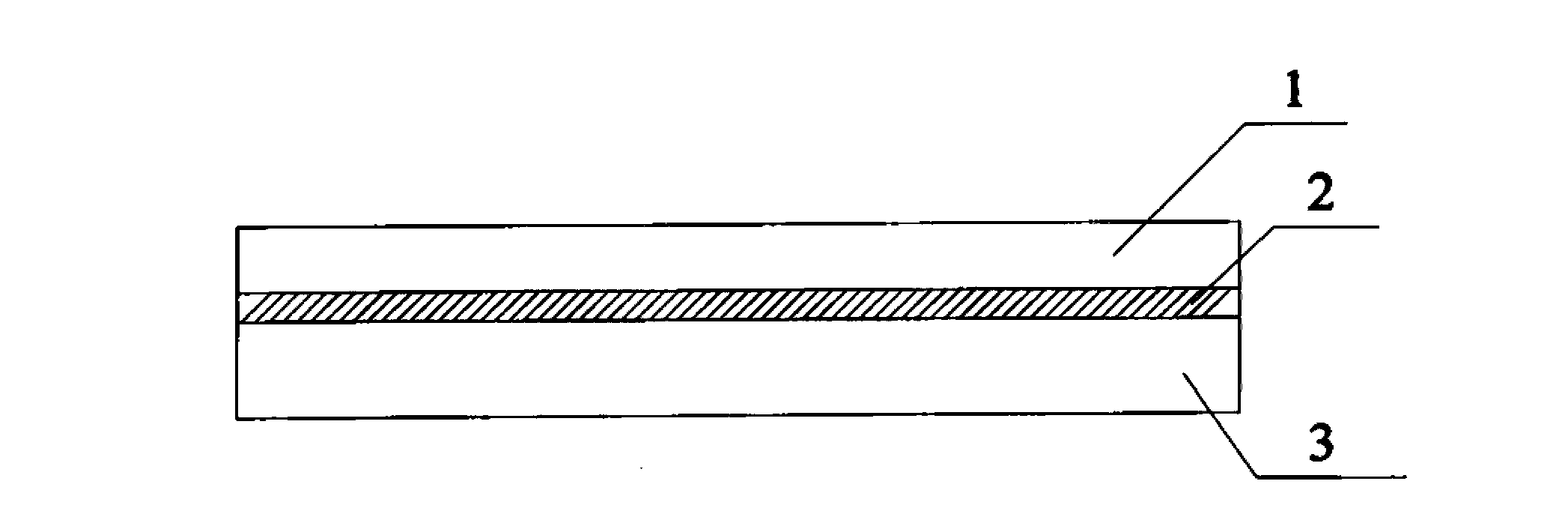Thermal insulation thermoplastic composite material for roadbed
A technology of composite materials and thermal insulation materials, applied in the field of thermal insulation thermoplastic composite materials for roadbeds, can solve the problems of poor impact resistance, non-corrosion resistance, high brittleness, etc., and achieve the effect of improving the application field, good thermal insulation performance, and good bonding strength
- Summary
- Abstract
- Description
- Claims
- Application Information
AI Technical Summary
Problems solved by technology
Method used
Image
Examples
Embodiment 1
[0041] A kind of thermal insulation thermoplastic composite material for roadbed, its structure is as follows figure 1 As shown, the heat-insulating thermoplastic composite material for the subgrade consists of three layers, the base layer 3 is the heat-insulation layer, the middle layer 2 is the high-strength adhesive layer, and the upper layer 1 is the thermoplastic composite material. The upper layer 1 thermoplastic composite acts as a skin layer to provide the strength of the entire composite. Rigidity and impact performance, the middle layer 2 adhesive layer serves as a transition layer to provide connection, and the base layer 3 mainly provides thermal insulation and antifreeze performance.
[0042] The above three layers of materials are bonded and pressed together by a high-strength adhesive layer. Among them, the thermoplastic composite material is carbon fiber reinforced nylon 6 copolymer (among them, the content of nylon 6 copolymer is 40%, the content of carbon fi...
Embodiment 2
[0048] A thermal insulation thermoplastic composite material for roadbed, the composite material has a three-layer structure, the base layer 3 is thermal insulation material, the middle layer 2 is a high-strength adhesive layer, the upper layer 1 is a thermoplastic composite material, and the above three layers are bonded by high-strength adhesive It is formed by bonding and pressing composite layers. Among them, the thermoplastic composite material is glass fiber-reinforced polypropylene copolymer, the high-strength bonding layer is an EVA film layer, and the insulation layer is a benzene board insulation layer.
[0049] The preparation method of thermal insulation thermoplastic composite material comprises the following steps:
[0050] (1) Pass the glass fiber reinforced polypropylene composite material with a fiber content of 55% and a resin content of 45% through a roller, the temperature of the roller is 150°C to heat and melt the composite material, and the pressure of t...
Embodiment 3
[0054] A thermal insulation thermoplastic composite material for roadbed, the composite material has a three-layer structure, the base layer is a thermal insulation material, the middle layer is a high-strength bonding layer, and the upper layer is a thermoplastic composite material, and the above three layers are bonded by a high-strength bonding layer Combined and pressed together. The thermoplastic composite material is a blend of carbon fiber reinforced polyethylene and polypropylene, the high-strength bonding layer is a Dow Corning DC7091 silica gel layer, and the insulation layer is a polyurethane insulation layer.
[0055] The preparation method of the above-mentioned thermal insulation thermoplastic composite material comprises the following steps:
[0056] (1) Pass the carbon fiber reinforced polyethylene and polypropylene composite materials with a fiber content of 50% and a resin content of 50% through the No. 1 roll, and the temperature of the No. 1 roll is control...
PUM
| Property | Measurement | Unit |
|---|---|---|
| Thickness | aaaaa | aaaaa |
| Thickness | aaaaa | aaaaa |
| Thickness | aaaaa | aaaaa |
Abstract
Description
Claims
Application Information
 Login to View More
Login to View More - R&D
- Intellectual Property
- Life Sciences
- Materials
- Tech Scout
- Unparalleled Data Quality
- Higher Quality Content
- 60% Fewer Hallucinations
Browse by: Latest US Patents, China's latest patents, Technical Efficacy Thesaurus, Application Domain, Technology Topic, Popular Technical Reports.
© 2025 PatSnap. All rights reserved.Legal|Privacy policy|Modern Slavery Act Transparency Statement|Sitemap|About US| Contact US: help@patsnap.com

